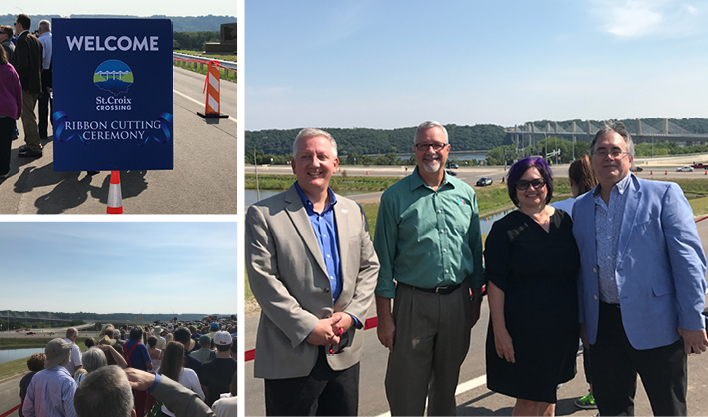After decades of debate and delay, the new St. Croix Crossing Bridge officially opened to traffic on August 2, 2017. A vital link between Minnesota and Wisconsin, the $646 million structure connects two states and several communities and bridges a gap between political parties; federal, state, and local agencies; and public and private groups that came together to make the project a success.
Built to Last
The new bridge, which replaces the historic Stillwater Lift Bridge, features an extradose design that combines the elements of a concrete box girder bridge with a cable-stay bridge. This innovative design utilizes shorter columns for the cabling and was an integral feature to limiting the visual impact to the National Scenic River area. Only the second bridge of its kind in the nation, the structure was specifically designed to complement the surrounding river valley and built to last a century or more.
Patience and Perseverance
While the new crossing relieves severe congestion and delays around the Stillwater community and provides St. Croix County residents with an easier commute to the Twin Cities, the project faced much controversy and criticism over the years – mostly related to environmental concerns regarding bridge construction.
To minimize potential impacts of the new bridge and roadway approaches as much as possible, SRF Consulting Group led the Environmental Impact Statement (EIS) – a decision-making tool that outlined the project’s environmental effects along with possible solutions. This effort, which spanned more than two decades, required a very involved stakeholder process with extensive coordination among federal, state, and local agencies. The EIS was also critical in gaining early approvals and ultimately helped develop the framework for the crossing we see today.
“Each community faced unique challenges. We assembled a package of mitigation strategies that satisfied everyone’s needs,” says Beth Bartz, AICP (Principal – Environmental and Transportation Planning). “This was a true team effort, and cooperation was key.”
The Supplemental EIS was supported by several specialized studies including extensive traffic forecasting, detailed traffic operations analysis, an economic impacts study, a visual impacts assessment, and cultural resource studies.
In addition to the EIS, SRF also led the project’s overall preliminary design, from the roadway approaches to the bridge to drainage and water resources – all of which played a key role in protecting the surrounding river bluffs and water quality. Approved by MnDOT, SRF’s preferred design alternative addressed specific stakeholder concerns such as speed, accessibility, pedestrian access, aesthetics, design standards, and the project’s physical footprint.
“SRF explored every possible way to make sure the bridge had minimal impacts to the river and ravines – from reducing the number of piers and preserving water quality to protecting the historic overlook and minimizing tree loss,” says Ken Holte, PE (Vice President – Civil Design). “This project turned out how we imagined and planned.”
The End of an Era
SRF’s Beth Bartz, Ken Holte, Walter Eshenaur, and Steve Wilson attended the ribbon cutting ceremony to celebrate the new bridge and the pivotal work they contributed that led to the project’s successful completion. Just down the river, the 80-year-old Stillwater Lift Bridge has closed to motor vehicles and will reopen to bicycle and pedestrian traffic in two years. Meanwhile, SRF is working with the City of Stillwater to complete its Downtown Framework Plan Update; this includes exploring new opportunities afforded by these major infrastructure projects and ensuring future improvements reflect the community’s vision and values.

